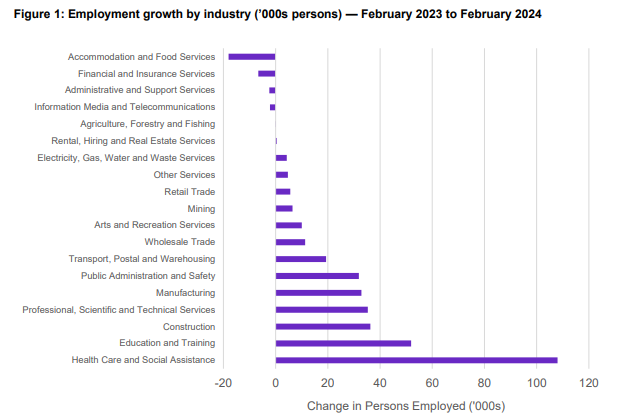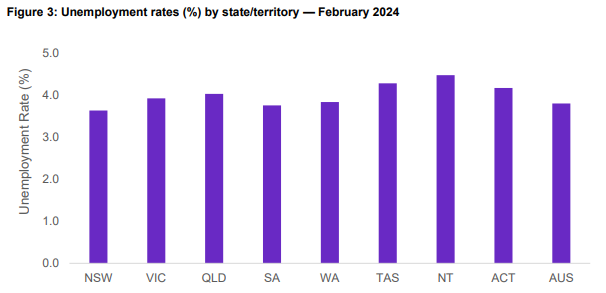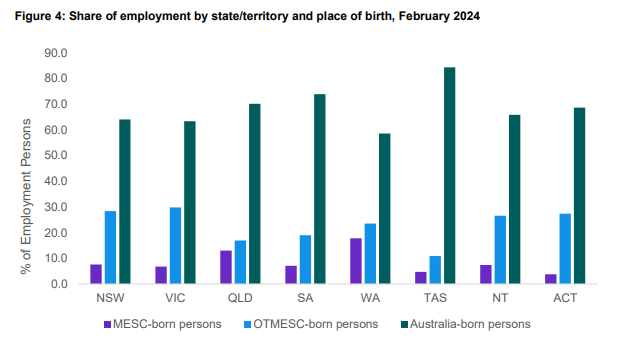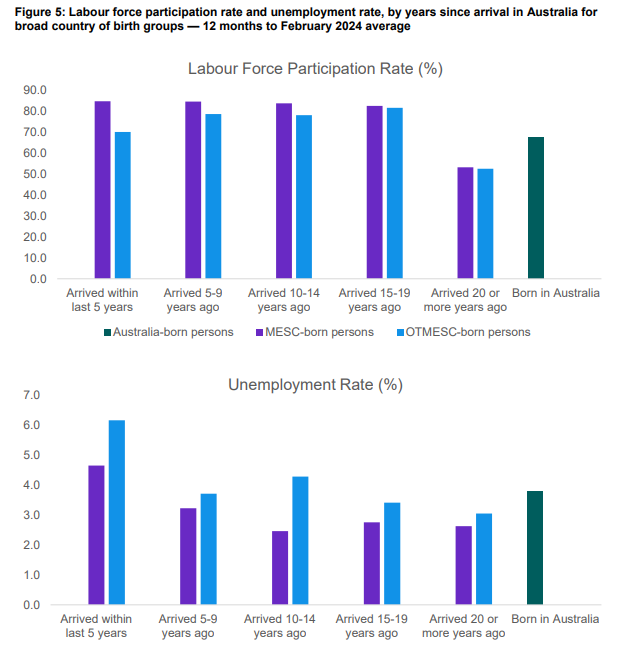Understanding the Australian Labour Market for Migrants
The Australian labour market continues to offer promising opportunities for migrants, despite some indicators suggesting a potential softening in the near future. This post aims to provide recent migrants, prospective visa applicants, and service providers with valuable insights into employment trends, industry performance, and regional differences.
Employment Trends: A Year in Review
Over the 12 months to February 2024, employment growth has varied significantly across different sectors. Notably, the Health Care and Social Assistance industry experienced the largest increase in employment, adding 108,000 jobs. Similarly, the Education and Training sector grew by 51,900 jobs, and the Professional, Scientific, and Technical Services industry saw an increase of 36,300 jobs.

Figure 1 shows a visual representation of the employment changes across various industries. This graph highlights the sectors with the most significant employment growth and decline, offering a clear picture of the market dynamics.
Regional Employment Distribution
Employment distribution by occupation varies across Australia’s states and territories. The Australian Capital Territory (ACT) leads with 60.8% of its workforce in high-skill occupation groups, followed by Victoria and New South Wales.

Figure 2 here to illustrate how different regions specialize in certain occupations. This visual aids in understanding regional employment patterns and can help migrants target specific areas based on their skills.
Unemployment Rates: A Closer Look
The national unemployment rate was 3.8% in February 2024, with variations across states. While South Australia saw a decrease in unemployment, other states like New South Wales and Victoria experienced slight increases.

Figure 3 at this point provides a snapshot of the unemployment landscape across different states, helping readers grasp where job-seeking efforts might be more challenging or rewarding.
Migrant Employment and Unemployment
Migrants from non-main English-speaking countries face higher unemployment rates, influenced by factors like language proficiency and recent work experience. The data shows a higher unemployment rate for newly arrived migrants compared to those who have been in Australia for longer periods.

Figure 4 here helps readers understand the employment distribution of migrants based on their country of birth across different states. MESC stands for Main English-Speaking Countries that include United Kingdom, the Republic of Ireland, South Africa, Canada, the United States of America and New Zealand, whereas, OTMESC stands for Other Than Main English-Speaking Countries.

Figure 5 here shows the challenges faced by new migrants and the gradual improvement in employment outcomes over time. It illustrates the integration challenges faced by migrants, particularly those from non-main English-speaking countries. While participation and employment improve with time, newly arrived OTMESC-born persons face higher unemployment and lower participation rates initially. Understanding these trends can help inform policies and support services aimed at improving migrant employment outcomes.
By focusing on targeted support for newly arrived migrants, especially those from OTMESC countries, Australia can further enhance the inclusivity and effectiveness of its labour market.
Occupational Growth: A Detailed Breakdown
Over the 12 months to February 2024, the largest increases in employment occurred for Professionals (up by 152,500), Clerical and Administrative Workers (up by 86,600), and Community and Personal Service Workers (up by 84,100). The smallest increase occurred for Sales Workers (up by 400).

Table 1 here highlights the growth in various occupational groups, providing a clearer picture of where the job opportunities lie.
Conclusion: Navigating the Australian Labour Market
Understanding the intricacies of the Australian labour market is crucial for migrants aiming to secure employment. The varying trends across industries and regions highlight the importance of targeted job searches and leveraging local opportunities.
For further detailed data and analysis, refer to the full publication from Jobs and Skills Australia. For personalized assistance and more expert insights, feel free to contact us at Ten Heads Immigration.
Disclaimer
This blog post summarizes and condenses information from the “Australian Labour Market for Migrants” publication by Jobs and Skills Australia. For the complete and detailed report, please refer to the official document available here.




